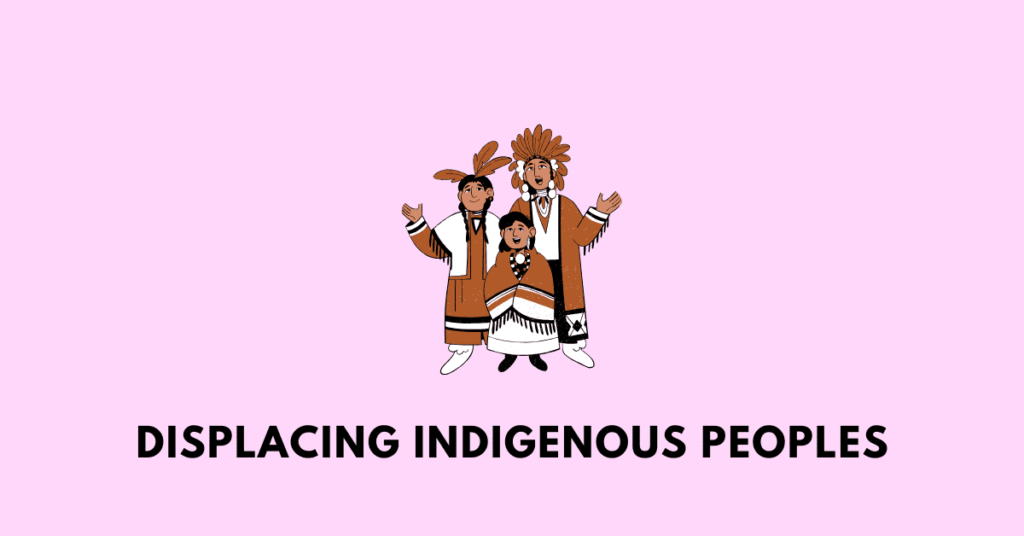Get summaries, questions, answers, solutions, notes, extras, PDF and guide of Class 11 (first year) History textbook, chapter 6 Displacing Indigenous Peoples which is part of the syllabus of students studying under AHSEC/ASSEB (Assam Board). These solutions, however, should only be treated as references and can be modified/changed.
If you notice any errors in the notes, please mention them in the comments
Summary
The chapter describes how European settlers displaced the indigenous peoples of America and Australia. It explains that before the Europeans arrived, these lands were home to many native groups who lived by hunting, fishing, and farming. They had their own languages, traditions, and ways of life. The arrival of settlers changed everything. Europeans considered the land as something to be owned, while the natives saw it as something to be shared.
In North America, European settlers pushed the natives off their land, often through unfair treaties or force. They introduced new ways of farming and built large industries, cutting down forests and hunting animals like bison to near extinction. The natives were moved to small areas called reservations, where they struggled to keep their traditions alive. Many native groups fought back, but the settlers, backed by strong armies, defeated them. Diseases brought by the settlers also killed many natives.
In Australia, a similar story unfolded. The British sent convicts to live there and take over the land. They saw the natives as primitive and did not respect their ways of life. Over time, most of the indigenous population was either killed or forced into difficult living conditions. Many children of mixed native and European descent were taken away from their families in an attempt to erase their culture.
For many years, history books ignored the suffering of the native peoples. They were seen as obstacles to progress. However, in the 20th century, people started to acknowledge these past injustices. Native groups fought for their rights, and laws were changed to recognise their traditions and land claims. Museums now display native history and culture, and governments have apologised for past wrongs.
The chapter also discusses how the settlers built modern countries like the USA, Canada, and Australia. They brought industries, railways, and large farms, but at the cost of native lands and lives. The idea of democracy and personal freedom spread, but these rights were initially only for white settlers. Slavery was another dark part of this history, as African people were brought in chains to work on farms. Even after slavery ended, black people faced discrimination for many years.
The chapter highlights how different the worldviews of settlers and natives were. The settlers wanted to own and profit from the land, while the natives lived in harmony with nature. This misunderstanding led to conflict, suffering, and the near destruction of native cultures. Today, efforts are being made to preserve what remains of these cultures and to recognise the struggles faced by indigenous peoples.

Video tutorial
Textbook solutions
Answer in Brief
1. Comment on any points of difference between the native peoples of South and North America.
Answer: The native peoples of North America lived in bands and villages along river valleys. They were primarily hunters and gatherers, eating fish and meat, and cultivating vegetables and maize. They often went on long journeys in search of meat, particularly bison. They did not attempt extensive agriculture, and since they did not produce a surplus, they did not develop kingdoms and empires like those in Central and South America. There were some quarrels between tribes over territory, but land ownership was not a major issue. They made formal alliances and friendships, exchanging goods as gifts rather than commodities.
In contrast, in South America, there were great kingdoms and empires such as the Aztecs and the Incas, which had centralized administration, extensive agriculture, and large-scale surplus production. These civilizations built large cities, had organized political systems, and developed written languages.
2. Other than the use of English, what other features of English economic and social life do you notice in nineteenth-century USA?
Answer: Other than the use of English, the features of English economic and social life in nineteenth-century USA included:
- The development of large-scale agriculture, with vast areas cleared and divided into farms.
- Introduction of crops like rice and cotton, which were grown for profit.
- The use of iron tools to cut down forests for farming.
- The construction of railways to connect distant places and facilitate trade.
- Industrialization, leading to the growth of industrial towns and factories.
- The concept of private property, where land was bought and sold for profit.
- The displacement of native peoples to reservations as settlers expanded westward.
- The introduction of slavery on plantations in the southern states, followed by its abolition after the Civil War.
- The influence of European settlers from Britain, France, Germany, Sweden, and Italy, who sought to own land.
- The perception that land should be used to its maximum capacity for profit.
- The use of barbed wire (invented in 1873) to protect farms.
- The rise of capitalist economic practices, including speculation, market-based trade, and industrial investments.
- The spread of Christianity and European cultural norms, often imposed on native populations.
3. What did the ‘frontier’ mean to the Americans?
Answer: The ‘frontier’ to the Americans meant the western boundary of their expanding land, a shifting line that moved further westward as settlers pushed into new territories. It represented both opportunity and struggle, a place for expansion, economic growth, and new settlements. The westward movement of the frontier led to the displacement of native peoples, forcing them to move further back. By 1892, the USA’s continental expansion was complete, and there was no longer a frontier left to conquer.
4. Why was the history of the Australian native peoples left out of history books?
Answer: The history of the Australian native peoples was left out of history books because, until the middle of the twentieth century, Australian history textbooks described how Europeans “discovered” Australia and hardly mentioned the native peoples except to suggest that they were hostile to Europeans.
Answer in a Short Essay
5. How satisfactory is a museum gallery display in explaining the culture of a people? Give examples from your own experience of a museum.
Answer: A museum gallery display can be a powerful tool in explaining the culture of a people, but its effectiveness depends on the way it is curated and presented. Museums often use artefacts, dioramas, and interactive displays to showcase the traditions, customs, and histories of various communities. In countries like the USA, galleries of ‘native art’ and special museums dedicated to indigenous ways of life help visitors understand these cultures. For example, the National Museum of the American Indian in the USA has been curated by American Indians themselves, ensuring an authentic representation of their culture.
Similarly, in Australia, galleries of native art have been added to art museums, and imaginative museum exhibits have been designed to explain native culture. This effort has been significant in preserving and promoting indigenous traditions. Without such displays, much of the cultural heritage of indigenous communities might have been forgotten over time.
From personal experience, visiting a museum that showcases dioramas, textiles, and artefacts has been an eye-opening way to understand a community’s history. However, while museum exhibits provide valuable insights, they can never fully replace firsthand experiences, oral histories, and living traditions practiced by people themselves.
6. Imagine an encounter in California in about 1880 between four people: a former African slave, a Chinese labourer, a German who had come out in the Gold Rush, and a native of the Hopi tribe, and narrate their conversation.
Answer: The sun was setting over California as four men, each from a different world, found themselves gathered around a small fire. They had all come to this land, willingly or unwillingly, seeking something—freedom, fortune, or simply survival.
The former African slave, now a free man, spoke first. “I was brought here in chains, forced to work on plantations in the South. Even after the war ended and we were freed, we still struggle for our rights. They say we are free, but we are not equal. Many of us are poor, forced to work the hardest jobs, while the whites look down on us. The landowners and businessmen control everything.”
The Chinese laborer, weary from years of laying railway tracks, nodded. “I came across the ocean to work on the railroads. Thousands of my people were brought here to build tracks across this land, but once the work was done, they turned against us. The government passed laws to stop more of us from coming. Many of my brothers were killed in riots, our businesses burned. They say we are taking their jobs, but we only do the work they refuse.”
The German, who had arrived during the Gold Rush, listened carefully. “I, too, came looking for opportunity. When I first arrived, there was gold in the rivers, and people thought they could become rich overnight. But soon, the gold was gone, and only the biggest companies made any money. Many miners like me became farmers, ranchers, or moved to the cities. I see how the big landowners push others aside, how they take the best land for themselves.”
The Hopi man, standing at the edge of the firelight, finally spoke. “Before all of you came, this land was ours. We did not own it like you do; we lived with it. But now, we are forced off our land, sent to reservations, given land that is not ours. They say we must become like them, farm like them, live like them. But we have our own ways, our own stories. They do not see that. They only see land they can take.”
A heavy silence fell among them. Each of them had suffered under a system that saw them as less than others. The fire crackled, and the wind carried their words into the vast California night.
Extras
Additional questions and answers
Coming soon
Additional MCQs
Coming soon

Get notes of other boards, classes, and subjects
